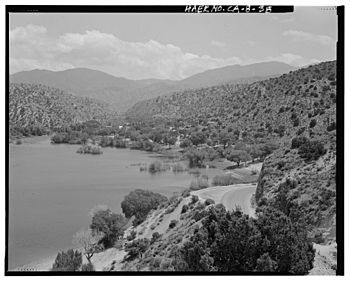Little Rock Creek (Los Angeles County, California) facts for kids
Quick facts for kids Little Rock Creek |
|
|---|---|

View to south over reservoir into Little Rock Creek Watershed
|
|
| Country | United States |
| State | California |
| Region | Los Angeles County |
| Cities | Littlerock, Palmdale |
| Physical characteristics | |
| Main source | Mount Williamson San Gabriel Mountains 8,000 ft (2,400 m) 34°22′16″N 117°51′35″W / 34.37111°N 117.85972°W |
| River mouth | Little Rock Reservoir 3,268 ft (996 m) 34°28′09″N 118°01′11″W / 34.46917°N 118.01972°W |
| Basin features | |
| Tributaries |
|
Little Rock Creek is a stream about 16.7-mile (26.9 km) long in northern Los Angeles County, California. It flows northwest through the San Gabriel Mountains and into the Mojave Desert.
The creek starts high up in the Angeles National Forest, near a peak called Mount Williamson. As it flows, it reaches the Little Rock Reservoir, which is held back by the Little Rock Dam. After the dam, the water continues as Little Rock Wash into the Antelope Valley in the western part of the Mojave Desert.
It's important to know that the California Office of Environmental Health Hazard Assessment has given advice about eating fish from Little Rock Reservoir. They suggest being careful because of certain substances found in the fish. You can find more details on their website.
History of Little Rock Creek
The name "Little Rock Creek" might sound a bit simple, but it has a reason. According to a scholar named Erwin Gudde, "little" is often used in place names when something is close to a larger feature. In this case, Little Rock Creek is near a bigger stream called Big Rock Creek.
In 1853, a group of explorers, including Lt. Robert Stockton Williamson and Colonel John Parke, visited Little Rock Creek. They were surveying the northern side of the San Gabriel Mountains for a railroad.
The first non-native person to settle in this area was Santiago García, who was born around 1833. He built a special kind of mud-brick house called an adobe. It was located on the north side of Little Rock Creek, about 0.5 miles (0.80 km) east of where the creek turned from flowing north to east.
This spot was special because the San Andreas Fault system made water come up to the surface, creating a wet area called a cienaga (a type of marshy canyon). This area was later named Santiago Canyon. Sadly, Santiago Garcia was killed by a grizzly bear in 1873.
Where Little Rock Creek Flows
Little Rock Creek begins just west of the top of Mount Williamson, which is about 8,199 feet (2,499 m) high. From there, it flows down the northern side of the San Gabriel Mountains.
The main smaller streams that join Little Rock Creek are South Fork Little Rock Creek and Santiago Canyon Creek. These join just before the creek reaches the Little Rock Reservoir. After the Little Rock Dam, the creek's name changes to Little Rock Wash. This wash ends in the Antelope Valley.
Little Rock Creek is part of the Antelope Valley Watershed. This is a special type of basin called a closed endorheic basin, which means its water doesn't flow out to the ocean. It's part of a larger water region called the South Lahontan Hydrologic Region.
Animals and Nature in the Creek
Little Rock Creek is home to some important and rare animals.
The lower part of Little Rock Creek is where you can find the endangered arroyo toad (Anaxyrus californicus). Because these toads are so special, a road called Little Rock Road and the nearby forested areas upstream from the reservoir have been closed to protect them.
Higher up in the creek, in a newly protected area called the Pleasant View Ridge Wilderness, lives another endangered animal: the mountain yellow-legged frog (Rana muscosa). This area is very important for these frogs.
The entire area around Little Rock Creek is protected. In October 2014, the San Gabriel Mountains National Monument was created, which helps keep the Little Rock Creek watershed safe and healthy for all its plants and animals.

